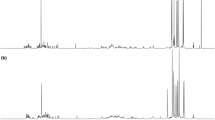Abstract
Synthetic pathways for a bridge type connection of two calixarenes by a flexible alkylene chain or a more rigid bistriazole modified connection element of different length are presented. NMR measurements as well as MM calculations point to rather flexible conjugates showing suitable requirements for a potential formation of inclusion complexes with neutral and anionic guests of appropriate size.
Graphical Abstract








Similar content being viewed by others
Notes
Calculated by means of combinational analysis, 10 conformations (n) of 2 individual chalices (c): [(n + c − 1)!/(n − 1!) ⋅c!].
First NMR-titrations of 17 with TBAX (X = F, Cl, Br, I) show lowfield shifts of aromatic triazole protons indicative for halide ion complexation. Further studies are owing.
References
Gutsche, C.D.: Calixarenes: an introduction (monographs in supramolecular chemistry). Royal Society of Cambridge, Cambridge (2008)
Scully, P.A., Hamilton, T.M., Bennett, J.L.: Synthesis of 2-alkyl- and 2-carboxy-p-tert-butylcalix[4]arenes via the lithiation of tetramethoxy-p-tert-butylcalix[4]arene. Org. Lett. 3, 2741–2744 (2001)
Gruber, T., Gruner, M., Fischer, C., Seichter, W., Bombicz, P., Weber, E.: Conforma-tional behaviour and first crystal structures of a calix[2]arene featuring a laterally posi-tioned carboxylic acid function in unsolvated and solvent-complexed forms. New J. Chem. 34, 250–259 (2010)
Fischer, C., Gruber, T., Seichter, W., Weber, E.: Bridge-substi-tuted calix[4]arenes: syntheses, conformations and application. Org. Biomol. Chem. 9, 4347–4352 (2011)
Baklouti, L., Vicens, J., Harrowfield, J.: Calixarenes in the nanoworld. Springer, Dordrecht (2007)
Thulasi, S., Savithri, A., Varma, R.L.: Calix[20bis(spirodienone) as a versatile synthon for upper rim alkoxylation of calixarenes and synthesis of novel triazole-based bis[calixarene] by ‘CuAAC’ chemistry. Supramol. Chem. 23, 501–508 (2011)
Morales-Sanfrutos, J., Ortega-Munoz, M., Lopez-Jaramillo, J., Hernandez-Mateo, F., Santoyo-Gonzalez, F.: Synthesis of calixarene-based cavitands and nanotubes by click chemistry. J. Org. Chem. 73, 7768–7771 (2008)
Harada, T., Rudziński, J.M., Shinkai, S.J.: Relative stabilities of tetramethoxycalix[4]-arenes: combined NMR spectroscopy and molecular mechanics studies. Chem. Soc. Perkin Trans. 2, 2109–2115 (1992)
Hertel, M.P., Behrle, A.C., Williams, S.A., Schmidt, J.A.R., Fantini, J.L.: Synthesis of amine, halide, and pyridinium terminated 2-alkyl-p-tert-butylcalix[4]arenes. Tetrahedron 65, 8657–8667 (2009)
Hardman, M.J., Thomas, A.M., Carroll, L.T., Williams, L.C., Parkin, S., Fantini, J.L.: Synthesis and ‘click’ cycloaddition reactions of tetramethoxy- and tetrapropoxy-2-(ω-azidoalkyl)calix[4]arenes. Tetrahedron 67, 7027–7034 (2011)
Ipaktschi, J., Hosseinzadeh, R., Schlaf, P., Dreiseidler, E., Goddard, R.: Self-organization of molecules by covalent bonds. Selective tetramerization of a para-quinodimethane. Helv. Chim. Acta 81, 1821–1834 (1998)
Estrada, L.A., Neckers, D.C.: Synthesis and photophysics of ambipolar fluoren-9-ylidene malononitrile derivatives. J. Org. Chem. 74, 8484–8487 (2009)
Fischer, C., Seichter, W., Weber, E.: Structural conditions required for the bridge lithiation and substitution of a basic calix[4]arene. Beilstein J. Org. Chem. 7, 1602–1608 (2011)
Fischer, C., Lin, G., Seichter, W., Weber, E.: Bridge-disubstituted calix[4]arenes obtained via new preparative route. Synthesis and structural study. Tetrahedron 67, 5656–5662 (2011)
Fischer, C., Bombicz, P., Seichter, W., Katzsch, F., Weber, E.: Bridge-disubstituted calix[4]-arenes in the rare 1,2-alternate conformation: control of the inclusion behaviour depending on the bridge substituents. Cryst. Growth Des. 12, 2445–2454 (2012)
Fischer, C., Bombicz, P., Seichter, W., Weber, E.: Fine-tuning of packing architecture: symmetrically bridge-disubstituted tetramethoxycalix[4]arenes. Struct. Chem. 24, 535–541 (2012)
Huisgen, R.: 1,3-Dipolar cycloadditions. Past and future. Angew. Chem. Int. Ed. 2, 565–598 (1963)
Huisgen, R.: Kinetics and mechanism of 1,3-dipolar cycloadditions. Angew. Chem. Int. Ed. 2, 633–645 (1963)
Yamabe, S., Tsuchida, N., Yamazaki, S.: A FMO-controlled reaction path in the Benzil-Benzilic acid rearrangement. J. Org. Chem. 71, 1777–1783 (2006)
Nishio, M., Umezawa, Y., Honda, K., Tsuboyama, S., Suezawa, H.: CH/π hydrogen bonds in organic and organometallic chemistry. CrystEngComm 11, 1757–1788 (2009)
Fischer, C., Gruber, T., Seichter, W., Schindler, D., Weber, E.: 5,11,17,23-Tetra-tert-butyl-25,26,27,28-tetramethoxycalix[4]arene dichloromethane hemisolvate. Acta Crystallogr. E64, o673 (2008)
Katzsch, F., Eißmann, D., Weber, E.: A comparison of X-ray crystal structures including methyl 3,5-bis(hydroxymethyl)benzoate, its phenylethynyl extended derivative in polymorphous forms and the corresponding carboxylic acids. Struct. Chem. 23, 245–255 (2012)
Li, Y., Flood, A.H.: Strong, size-selective, and electronically tunable C–H···halide binding with steric control over aggregation from synthetically modular, shape-persistent [34]triazolophanes. J. Am. Chem. Soc. 130, 12111–12122 (2008)
Fischer, C., Stapf, M., Seichter, W., Weber, E.: Fluorescent chemosensors based on a new type of lower rim dansylated and bridge substituted calix[4]arenes. Supramol Chem. doi:10.1080/10610278.2013.783918 (2013)
Acknowledgments
ADDE (Cluster of Excellence “Structure Design of Novel High-Performance Materials via Atomic Design and Defect Engineering”) is acknowledged for founding of the modelling software.
Author information
Authors and Affiliations
Corresponding author
Electronic supplementary material
Below is the link to the electronic supplementary material.
Rights and permissions
About this article
Cite this article
Fischer, C., Weber, E. Bis-calix[4]arene-based podants using the bridge position as a constructive mode of subunit connection. J Incl Phenom Macrocycl Chem 79, 151–160 (2014). https://doi.org/10.1007/s10847-013-0338-6
Received:
Accepted:
Published:
Issue Date:
DOI: https://doi.org/10.1007/s10847-013-0338-6



